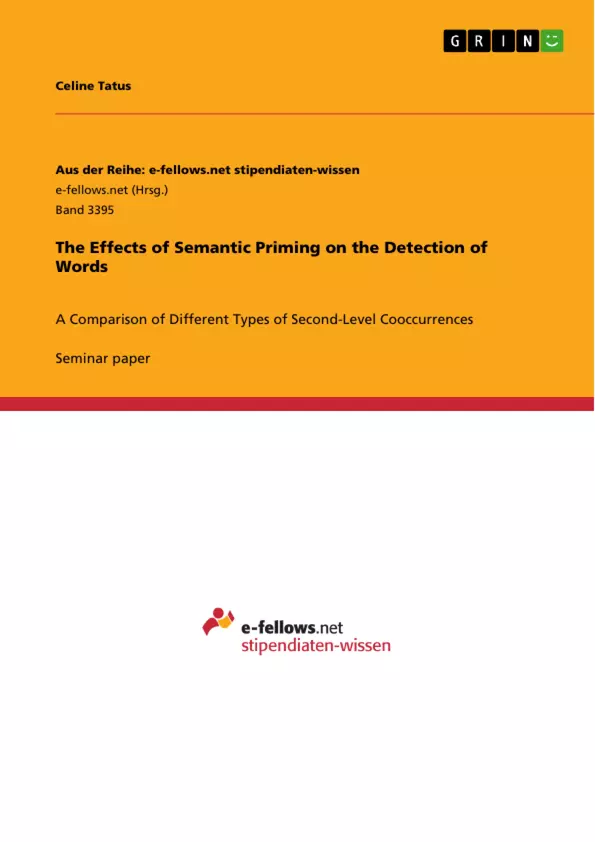In order to retrieve information more efficiently and quickly, our central nervous system makes use of implicit preactivation of associative neural networks. In this study, 78 participants were instructed to identify a sequence of word pairs consisting of either German words, nonwords or pseudowords within a lexical decision task.
The procedure was carried out under three different conditions: a) no associations within a word pair, b) connection through general second-level cooccurrences, and c) connection through lemmatized second-level cooccurrences. The analysis of variance revealed highly significant differences in reaction time and error rate between lemmatized second-level cooccurrence compared to general second-level cooccurrences. Both, error rate and reaction time, were lower for lemmatized second-level cooccurrences.
Stimuli consisting of words with second-level association had a positive effect on the reaction time and error rate.
This could be proven due to a stimulus onset asynchrony of 50ms, avoiding semantical competition that could cause inhibitory effects on the reaction time. Linear regression also revealed that lemmatized second-level cooccurrences had a greater influence on the reaction time up to the target and the error rate compared to general second-level cooccurrences. This information could be used to improve models that explain the process of word recognition by adding the influence of the lemmatized second-level cooccurrence.
Inhaltsverzeichnis (Table of Contents)
- Abstract
- List of tables
- List of figures
- 1 Introduction
- 1.1 Theoretical background
- 1.2 Question
- 1.3 Hypothesis
- 2 Material and Methods
- 2.1 Experimental subjects
- 2.2 Stimulus material
- 2.3 Test procedure
- 3 Results
- 3.1 Descriptive Statistics
- 3.2 Inferential statistics
- 4 Discussion
- 4.1 Conclusion
- 4.2 Critique
- 4.3 Outlook
- Bibliography
Zielsetzung und Themenschwerpunkte (Objectives and Key Themes)
The objective of this study is to investigate the effects of semantic priming on the detection of words, specifically focusing on the difference between general and lemmatized second-level cooccurrences. This study aims to contribute to understanding how the brain processes information and how semantic associations influence word recognition.
- Semantic priming and its role in word recognition
- The influence of different types of cooccurrences on reaction time and error rate
- Comparison of general and lemmatized second-level cooccurrences in lexical decision tasks
- Application of spreading activation and interactive activation models to explain the observed effects
- Implications for improving models of word recognition.
Zusammenfassung der Kapitel (Chapter Summaries)
- Chapter 1: Introduction - This chapter provides a theoretical background on semantic priming, discussing the concept of priming, its different types, and the relevance of spreading activation models in explaining the process. It also introduces the research question and hypothesis of the study.
- Chapter 2: Material and Methods - This chapter details the experimental design, including the participants, stimulus material, and the test procedure used to measure reaction time and error rate during a lexical decision task.
- Chapter 3: Results - This chapter presents the descriptive and inferential statistics obtained from the experiment, including the comparison of mean group differences for reaction time and error rate across different conditions of cooccurrences. It also presents results from linear regression analysis.
- Chapter 4: Discussion - This chapter discusses the findings of the study, interpreting the results in the context of existing theories and models. It highlights the significance of the findings for understanding the effects of semantic priming and proposes further research directions.
Schlüsselwörter (Keywords)
The primary keywords and focus topics of this work encompass the domains of cognitive psychology, language processing, and semantic memory. This study investigates the role of semantic priming in word recognition, exploring the influence of different types of second-level cooccurrences on reaction time and error rate. Key terms include: spreading activation network model, interactive activation model, semantical priming, general associations, lemmatized, cooccurrences, error rate, reaction time, lexical decision task, stimulus onset asynchrony, and bim, jo, jobimtext.
- Arbeit zitieren
- Celine Tatus (Autor:in), 2019, The Effects of Semantic Priming on the Detection of Words, München, GRIN Verlag, https://www.grin.com/document/538989



